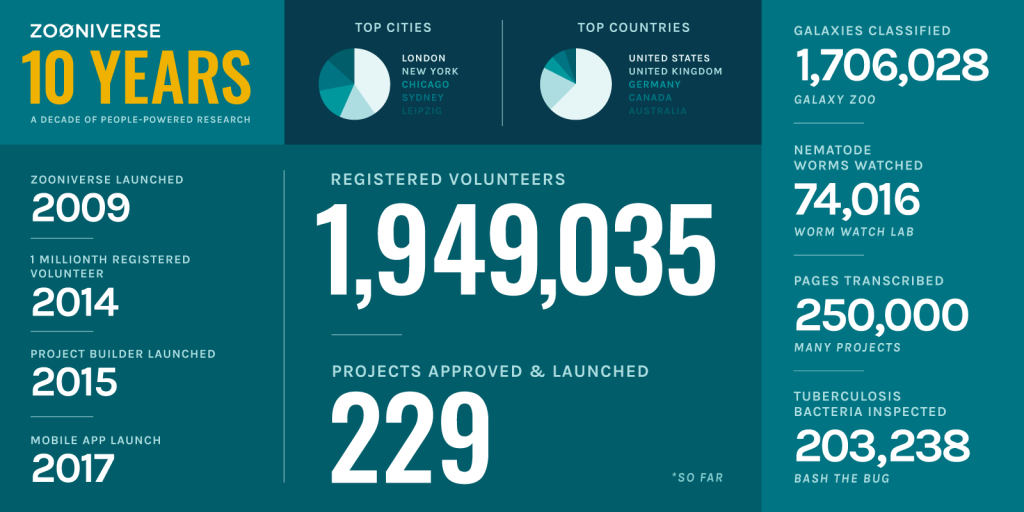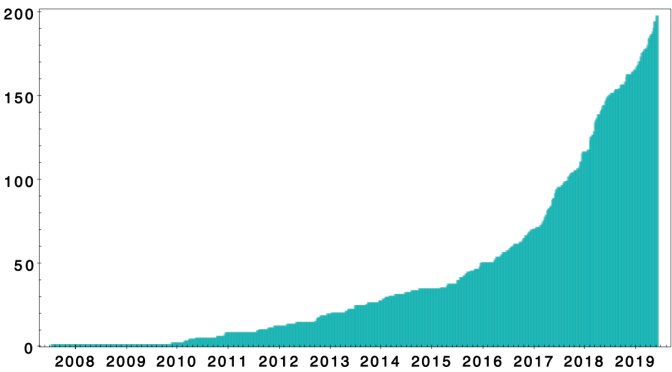Zooniverse is ten years old! On 12th December 2009, Zooniverse.org sputtered into life, celebrated with a post on this very blog (https://blog.zooniverse.org/2009/12/12/the-zooniverse-is-go/). Truth be told, there wasn’t a huge amount to show – the only project there was our first, Galaxy Zoo, which had been running for a couple of years by that point. What a contrast to today’s bustling home page, with 229 live projects for you to choose from. Early in 2010 two new projects – Solar Stormwatch and Moon Zoo – were launched, before Old Weather became our first project based here on Earth instead of out in the cosmos.

To celebrate, we’re redoubling our efforts to reach two million volunteers. We’re about 50,000 short, so if every one in twenty of you invites a friend to join in we’ll be there in no time. We have a prize lined up for the lucky two millionth, and anyone who classifies on any project on that auspicious day will go into a draw for some Zooniverse swag.
Birthdays are also time for reflection. To be honest, I was a bit surprised when I realised that we were approaching this milestone birthday. Galaxy Zoo had arrived with a big bang, a sudden explosion of effort, but as the above description suggests Zooniverse grew more slowly, as project after project was added to our nascent platform. Over the years, we rebuilt the codebase (more than once), projects came and went, and the army of Zooniverse volunteers grew in strength and in numbers. Looking back, though, the decision we made to launch Zooniverse set in stone some important principles that still guide us today.
For starters, it meant that we were committed to building a universe of projects which volunteers could move easily between. Projects which were lucky enough to get publicity – featuring on BBC Stargazing Live, for example – thus benefited other projects by bringing new people into the Zooniverse community. We built a shared codebase, so that funding for a particular project could support the development of code that benefited everyone. For most participants, their experience of the Zooniverse is limited to the project they’re participating in, whether it involves penguins, papyri or planets, but these network effects have been hugely important in sustaining such a rich variety of projects for a decade.
We’ve always tried to make it as easy as possible for researchers to build the best projects they can imagine, investing in the project builder tool that now supports all of the projects listed on our homepage. The choice – made early – to present the Zooniverse as a tool that’s free for researchers to use has caused problems; we are almost completely dependent on grant funding, which is a risky way to run a railroad, to say the least. But it has meant that those researchers, often early in their careers, have been able to turn to Zooniverse for help without reservation, and I think we’ve had better results – and more fun – as a consequence.
There have been so many great moments over the last ten years, but just for a bit of fun here are my top 3 favourites:
- First hearing the Solar Stormwatch results were good – realising the method doesn’t just work for Galaxy Zoo.
- Climbing up a hill in the Antarctic to retrieve Penguin Watch data.
- The morning where we thought Higgs Hunters volunteers had discovered something truly remarkable (sadly it turned out they hadn’t).
So here’s to ten years of the Zooniverse. At any point in the last decade, I’d have been wrong if I’d tried to predict what the next few years would bring. I’m looking forward to more adventures and surprises in our second decade!
Chris
PS I can’t possibly list all of the people who were instrumental in building and guiding the project over the years, but I hope the team will forgive me for mentioning Arfon Smith, my co-founder and the technical genius behind the Zooniverse’s first few years, Lucy Fortson, whose wisdom we’ve relied on from the start, and Lauras Whyte and Trouille who have in turn led the Adler team in Chicago through this mad decade. Special thanks too to the volunteers – all of you – but especially Elisabeth Baeten, Jules Wilkinson, and PMason, whose spirit and generosity is a constant source of wonder and inspiration.

